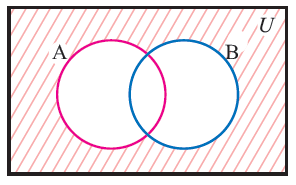VENN DIAGRAM OF A INTERSECTION B WHOLE COMPLEMENT
Here we are going to see how to draw a venn diagram of A intersection B whole complement.
Venn diagram of (A n B)' :
To represent (A n B)' in venn diagram, we have to shade the region except the common regions of A and B.
(A n B)'

A' U B'

Venn diagrams for (A n B)' = A' U B'
Let us look into some examples to understand the above concepts.
Example 1 :
Use the Venn diagram to answer the following questions
List out the elements of the following sets
|
(1) U |
(2) G |
(3) H |
(4) G' |
|
(5) H' |
(6) G' n H' |
(7) n(GUH)' |
(8) n(GnH)' |

Solution :
(1) To find the elements of universal set U, we have to list out all the elements that we find in the rectangular box.
U = { 1, 2, 3, 4, 5, 6, 8, 9, 10 }
(2) To write the elements of set G, we have to list out the numbers that we find in the circle G.
G = { 1, 2, 4, 8}
(3) To write the elements of set H, we have to list out the numbers that we find in the circle H.
H = { 2, 6, 8, 10}
(4) To find the elements of the set G', we have to list out all the elements other than the circle G.
G' = { 3, 5, 6, 9, 10 }
(5) To find the elements of the set H', we have to list out all the elements other than the circle H.
H' = { 1, 3, 4, 5, 9 }
(6) G' n H' = { 3, 5, 9 }
(7) To find (G U H)', first we have to find the elements of
G U H = {1, 2, 4, 6, 8, 10}
(G U H)' = {3, 5, 9}
n (G U H)' = 3
(8) To find (G n H)', first we have to find the elements of
G n H = { 2, 8}
(G n H)' = { 1, 3, 4, 5, 6, 9, 10 }
n (G n H)' = 7
Example 2 :
If U = {x : 1 ≤ x ≤ 10, x ∊ N}, A = {1, 3, 5, 7, 9} and B = {2, 3, 5, 9, 10}, find
(i) A' (ii) B' (iii) A' U B' (iv) A' ⋂ B'
Solution :
U = { 1, 2, 3, 4, 5, 6, 7, 8, 9, 10 }
A = {1, 3, 5, 7, 9}
B = {2, 3, 5, 9, 10}
(i) A' = { 2, 4, 6, 8, 10}
(ii) B' = { 1, 4, 6, 7, 8}
(iii) A' U B' = { 1, 2, 4, 6, 7, 8, 10 }
(iv) A' ⋂ B' = { 4, 6, 8 }
Related topics
- Venn diagram A U B
- Venn diagram A n B
- Venn diagram of A'
- Venn diagram of B'
- Venn diagram of (AUB)'
- Venn diagram of (AnB)'
- Venn diagram of A\B
- Venn diagram of B\A
Kindly mail your feedback to v4formath@gmail.com
We always appreciate your feedback.
©All rights reserved. onlinemath4all.com
Recent Articles
-
Digital SAT Math Problems and Solutions (Part - 101)
Jan 26, 25 07:59 PM
Digital SAT Math Problems and Solutions (Part - 101) -
AP Calculus AB Problems with Solutions (Part - 7)
Jan 26, 25 06:56 AM
AP Calculus AB Problems with Solutions (Part - 7) -
Digital SAT Math Problems and Solutions (Part - 103)
Jan 25, 25 01:00 AM
Digital SAT Math Problems and Solutions (Part - 103)


